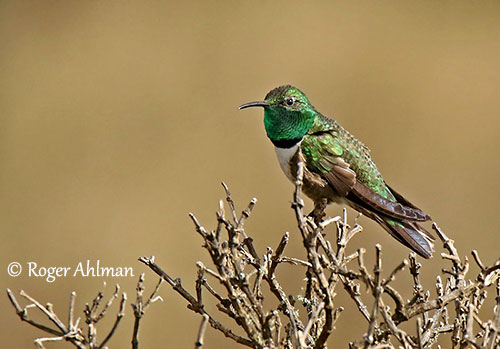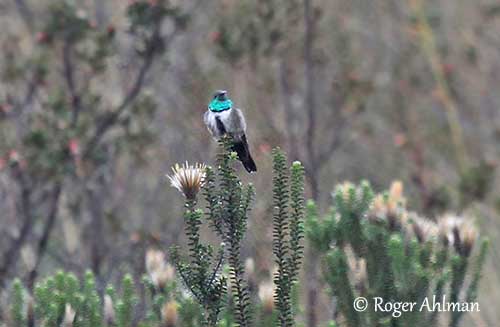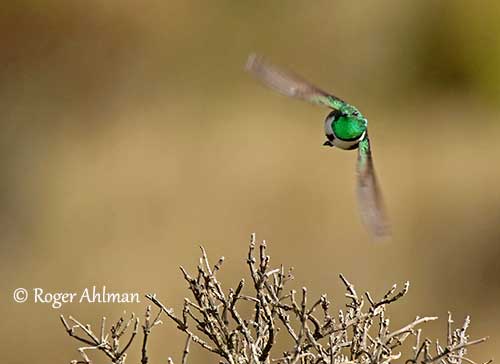
REPRODUCTION OF THIS SPECIES:
The breeding season takes place between February and June, occasionally to August.
The Green-headed Hillstar nests in a bulky structure, a cup-shaped nest made with moss and vegetal fibres. It is built in rocky cavities, or under overhanging rock, in caves, on roofs or inside open buildings.
The female lays two white eggs and incubates alone during 19-21 days. At hatching, the chicks are fairly dark, with two rows of greyish down on the back. They fledge 36-40 days after hatching.
PROTECTION / THREATS / STATUS:
The Green-headed Hillstar is affected by habitat degradation caused by expansion of agriculture.
The size of the population is unknown, but the species is described as “fairly common” and the numbers are suspected to be stable.
The Green-headed Hillstar is not globally threatened and currently evaluated as Least Concern.
Fr: Colibri de Stolzmann
Ang: Green-headed Hillstar
All: Grünkopf-Andenkolibri
Esp: Colibrí de Stolzmann
Ita: Orostella testaverde
Nd: Peruaanse Bergnimf
Sd: grönhuvad bergstjärna
Photographer:
Roger Ahlman
Pbase Galleries Peru and Ecuador
Text byNicole Bouglouan
Sources:
HANDBOOK OF THE BIRDS OF THE WORLD Vol 5 by Josep del Hoyo-Andrew Elliott-Jordi Sargatal - Lynx Edicions - ISBN: 8487334253
Birds of Ecuador De Robin Restall, Juan Freile – Editeur: Bloomsbury Publishing, 2019 – ISBN: 147297249X, 9781472972491 - 576 pages
Ornithomedia - Le Web de l’Ornithologie
Wikipedia, la enciclopedia libre
Wikipedia, the free encyclopaedia
Green-headed Hillstar
Oreotrochilus stolzmanni
Apodiformes Order – Trochilidae Family
INTRODUCTION:
The Green-headed Hillstar was formerly lumped into Andean Hillstar , but it is now a full species. Both species differ in intensity of plumage with more or less metallic or glittering colours.
The Green-headed Hillstar is found in the Andes of N and C Peru, and recently in S Ecuador. It frequents alpine grassland and scrub from 3,600 to 4,200 metres of elevation. It typically feeds on nectar and pollen of various plant species. Like other members of genus Oreotrochilus, it clings to flowers instead of hovering to save energy in the cold environment. It nests in a cup-shaped structure built in rocky cavities or under overhanging rock, and also in buildings.
The Green-headed Hillstar is affected by habitat degradation caused by agriculture expansion, but currently, the species is not globally threatened.
The name of this species pays tribute to the Polish zoologist Jean Stanislaus Stolzmann (1854-1928).

DESCRIPTION OF THE BIRD:
Biometrics:
Length: 13-14 cm
Weight: 7,9-8,4 g
The Green-headed Hillstar adult male has greenish upperparts with bronzy sheen including scapulars and head. Flight-feathers and rectrices are dark brown, with greenish sheen on central rectrices.
On the underparts, chin, throat and lower cheeks are emerald green. The throat is underlined by a black line separating it from the white rest of underparts. We can see a narrow, vertical black line in the middle of the belly. Flanks are pale buff. The undertail feathers are whitish with dull bronze central rectrices.
The black bill is slightly decurved. The eyes are dark brown. Legs and feet are blackish.
Both male and female have a small white spot on the rear eye.
The adult female resembles male but she has white throat with greyish spots. The underparts are whitish. The tail is dark greenish with white bases and tips to outer rectrices.
The juvenile resembles female.
RANGE:
The Green-headed Hillstar is found in the Andes of northern and central Peru, and more recently in far southern Ecuador.
HABITAT:
The Green-headed Hillstar frequents rocky alpine grassland and scrub in puna, from 3,600 to 4,200 metres of elevation.
It favours the areas with stands of Puya (Bromeliaceae) and Polylepis forests.
CALLS AND SONGS: SOUNDS BY XENO-CANTO
The sounds uttered by the Green-headed Hillstar are poorly known, but they are probably fairly similar to the calls and songs of the Andean Hillstar, with a short, repeated “tsip” and a melodious twittering during chasing and displays.

BEHAVIOUR IN THE WILD:
The Green-headed Hillstar feeds on nectar and pollen from several plant species such as Chuquiraga, Cajophora and Puya, and some cacti.
It feeds mainly by clinging or perching instead of hovering in front of the flowers. This behaviour allows the bird to conserve energy in the cold mountainous environment at high altitude.
They also catch insects in the air by hawking.
The Green-headed Hillstar usually forages less than three metres from the ground, usually perching on inflorescences. It may occasionally come to the ground in open areas.
The feeding territory is more often defended by the male than the female.
The displays are unknown, but we can suggest that the bright-coloured throat is enhanced by adapted postures during the courtship displays accompanied by melodious twittering.
During the cold nights in high mountains, the Green-headed Hillstar sleeps in sheltered places, often cavities in rocks or caves. Several birds often roost together.
Like other Trochilidae, they enter a state of torpor to conserve energy and to survive in their cold environment, especially during the night.
The Green-headed Hillstar is sedentary but it may wander seasonally and locally to lower elevations.
It rarely hovers and only performs short-distance flights.
